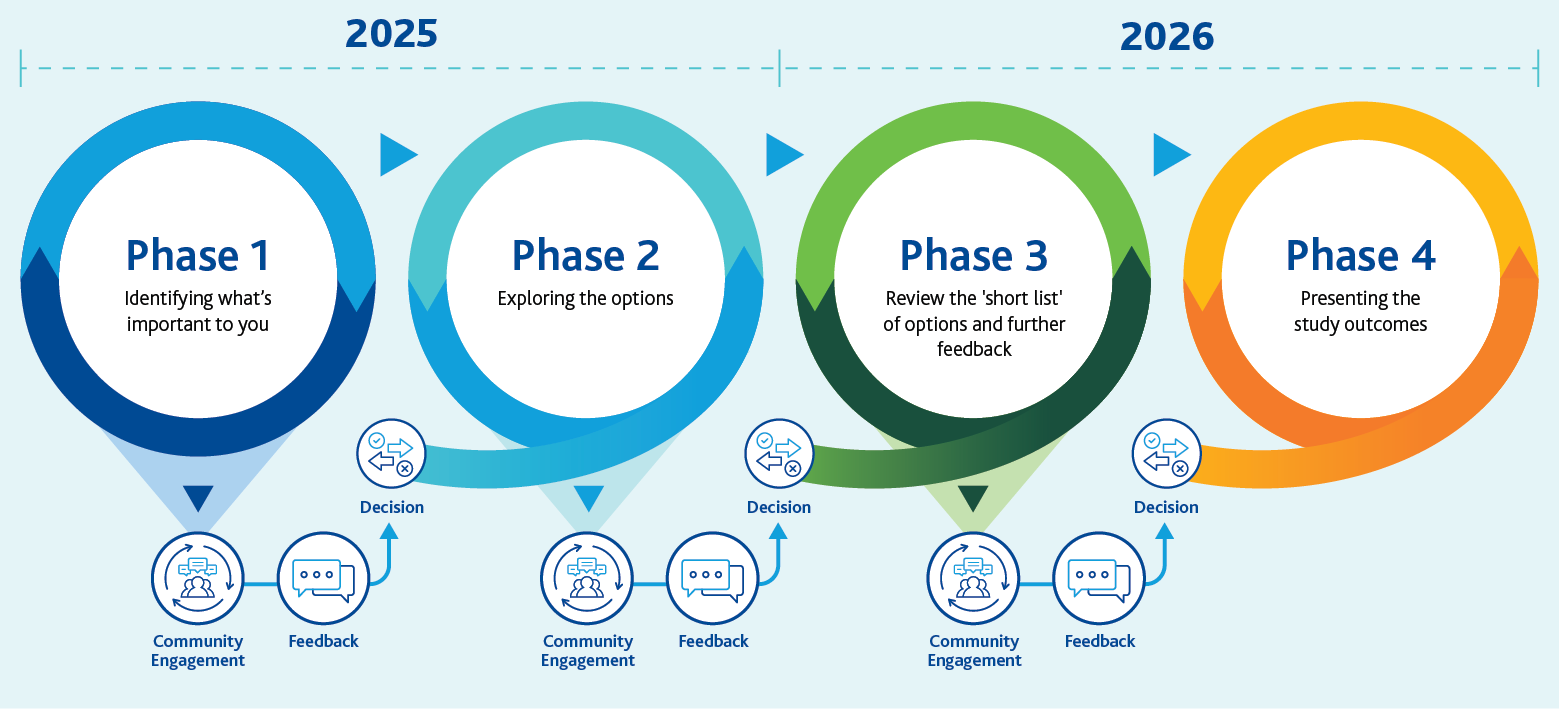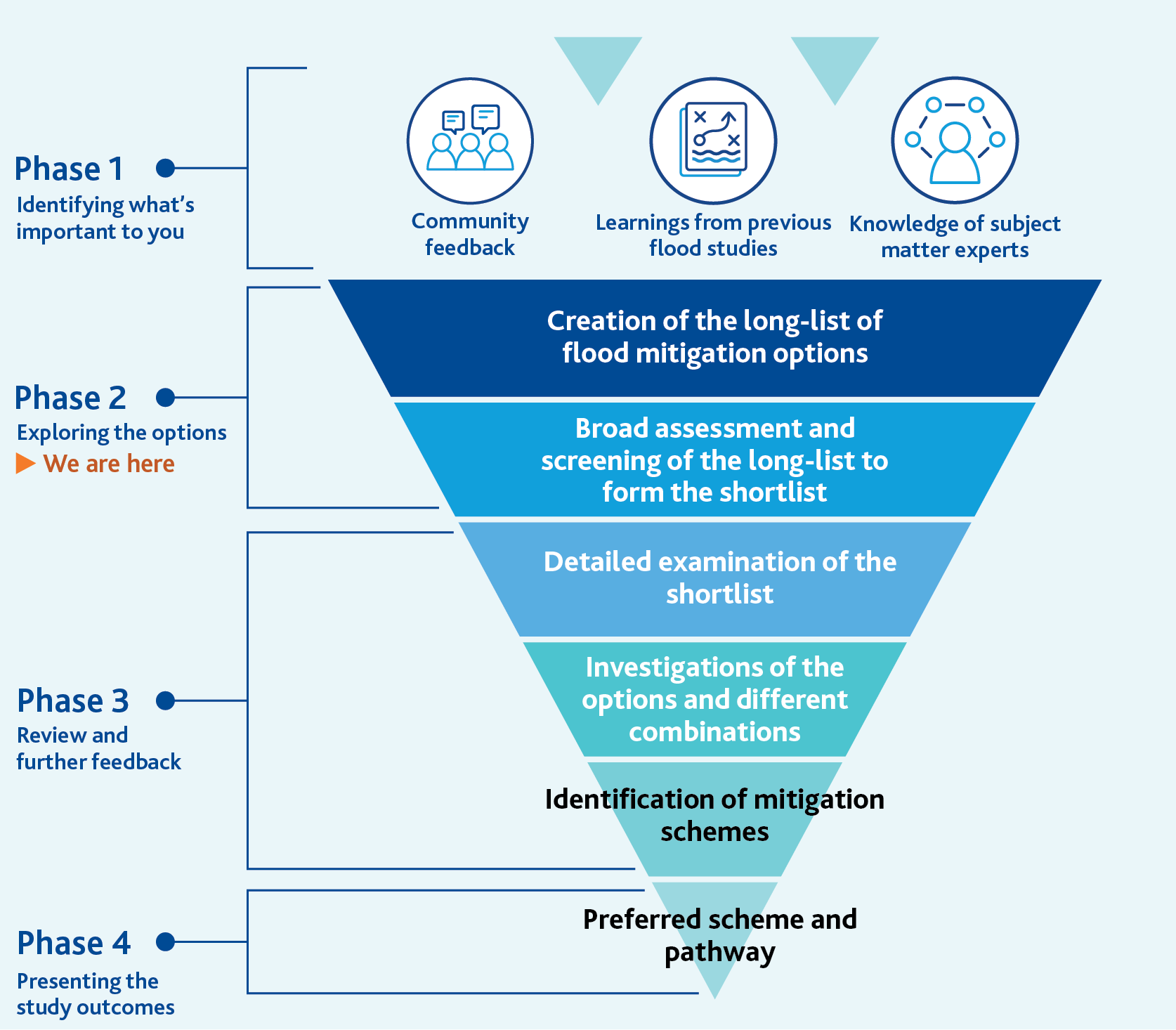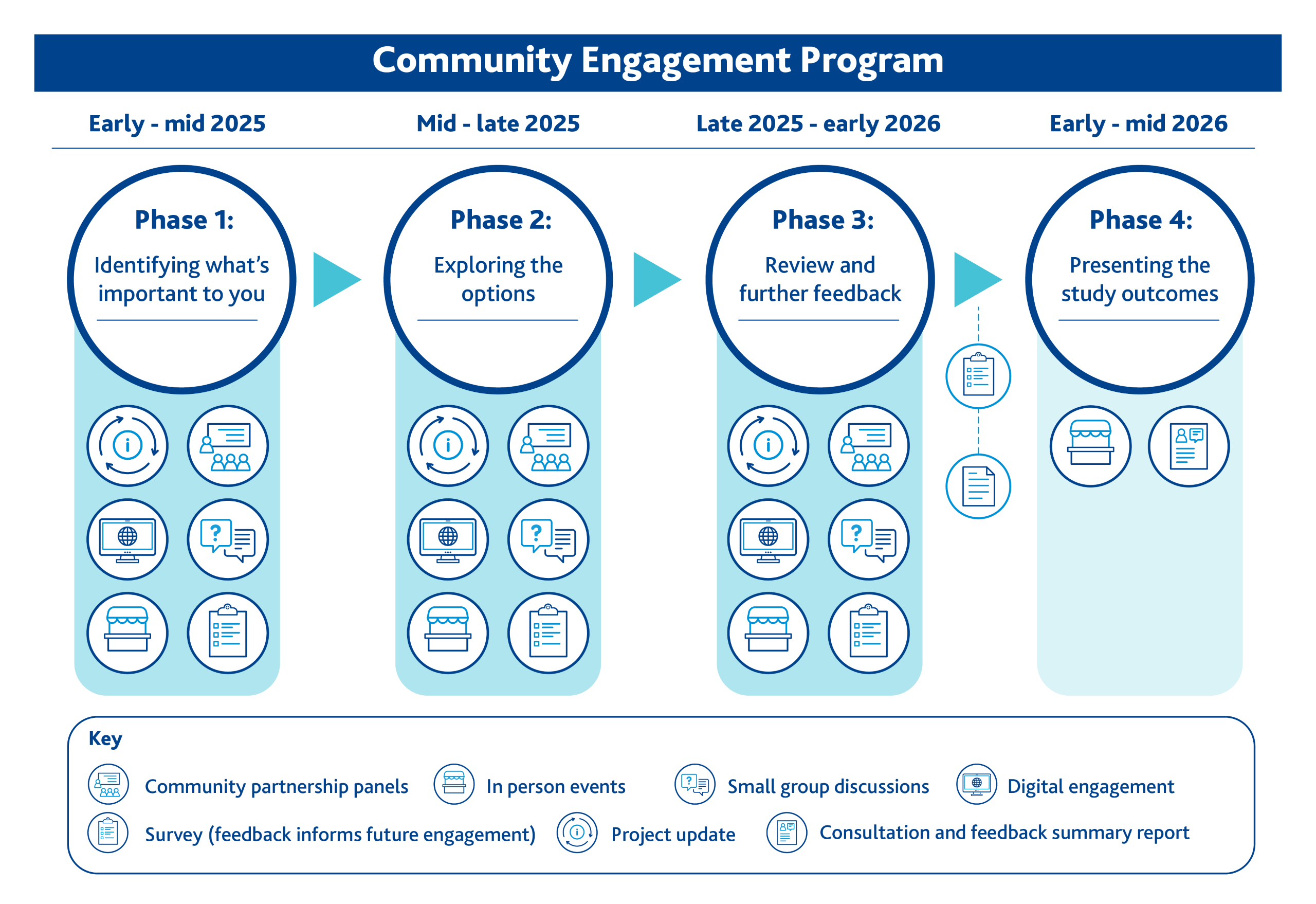Community events
View recordings, FAQs and summaries from past events.
This study supports work to identify, develop and implement flood mitigation options for the lower Maribyrnong River catchment.
The mitigation options will help to reduce overall risk from the possibility and consequences of a flood, while reflecting community values as much as possible.
Thanks for sharing your feedback on the long-list of flood mitigation options and the criteria used to evaluate them. Your input will help refine the options into a shortlist that will be assessed in detail, which we’ll seek your feedback on in the next phase of this study.
We’re now preparing a summary of what we heard, which we’ll share with you in early 2026. To receive updates by email, including on upcoming opportunities to have your say, follow this webpage:
View the full or screened list of options via our downloadable handbook or Options Map.
The criteria will be used to refine the long-list of options into a shortlist.
Late 2025 to early 2026:
Early to mid 2026:
To receive email updates on the study and future opportunities to get involved, select the ‘follow’ button at the top of this page.
The study will investigate flood mitigation options which aim to support a reduction in future flood risk, and which prioritise the safety of communities in the catchment area.
For example:
For example:
For example:
For example:
Due to the size and diversity of the Maribyrnong River catchment, a number of options are likely to be identified. These might include options that could be implemented in the short and medium term (at least 5 years), and others which will take considerable time to implement (at least 10-15 years).



You shared what you value about your local environment and community, and mitigation options you'd like to see explored.
Our online survey asked about your experiences and ideas for flood mitigation options to inform a ‘long-list’ of potential options.
Melbourne Water respectfully acknowledges the Bunurong, Gunaikurnai,
Taungurung, Wadawurrung and Wurundjeri Woi-wurrung peoples as the Traditional
Owners and Custodians of the land and water on which we rely and operate.
We
pay our deepest respects to their Elders - past, present and emerging.
This site is owned and operated by Melbourne Water using software licensed from Social Pinpoint. For details on how Melbourne Water collects and protects your personal information, refer to their Privacy Policy below. For details of how Social Pinpoint may access personal information, please refer to Social Pinpoint’s Privacy Policy.
Melbourne Water Corporation (Melbourne Water) (“we”, “us”, “our”) respects the privacy of personal information of participants using this site.
Our collection, use and disclosure of your personal information is regulated by Victorian privacy laws including the Privacy and Data Protection Act 2014. You can find more information about your privacy rights at the Office of the Victorian Information Commissioner website.
This privacy statement applies to the Let's Talk | Melbourne Water website. For information about the broader collection and use of personal information by Melbourne Water, please refer to our Privacy Policy | Melbourne Water on our main website.
We only collect personal information online when you choose to provide it.
The purpose for collecting your personal information is to manage online participation in our engagement related to our services, projects and plans and to communicate with you about them if you agree to updates. We or our Contract Service Providers may also use your personal information for customer research purposes, consistent with our main Privacy Policy.
You can access Let's Talk | Melbourne Water’s website anonymously, without disclosing your personal information.
This site’s web-server automatically collects the following non-personal information (i.e. clickstream data) for statistical and system administration purposes only:
We collect this information to evaluate the performance of our online services and product offerings. To the extent that this data could make you identifiable, Melbourne Water will not attempt to identify individuals from the records the server automatically generates unless necessary to investigate a breach of law or regulation.
Cookies are used on the site, but they do not collect any personal information. For the most part they are sessional and just contain system-generated values to identify the user's session for statistical and system administration purposes only.
If you choose to sign up at the site we invite you to enter a username, email address and postcode.
If you choose to respond to forum questions we require a username and an email address. Only your username will be visible to other participants when they view responses.
We recommend you use an anonymous username if you do not want your real name visible on the website with forum comments, stories or questions.
By providing an email address you help us protect the integrity of the discussion from individuals and groups who may attempt to unduly influence the outcomes of the consultation process. For example, we check the database to ensure each user has a single email account on the site. We also frequently review the site for trolls and spammers.
We ask optional demographic questions when you sign-up to help us determine whether we are getting a diverse cross-section of participants. These questions are age group and gender.
If you use your Facebook account to log in and/or authenticate with the Melbourne Water Let's Talk portal, we will collect and store a unique user ID provided by your social networking site (‘SNS’) .
As a Melbourne Water Let's Talk portal user, you can choose to log in and/or authenticate with a SNS, such as Facebook. To do so, you must use your account credentials (typically username and password) for your SNS. Your SNS will provide Melbourne Water with a unique user ID which we can use to identify you on our Let's Talk portal. Melbourne Water will retain this user ID, keep it private and use it to identify you and enable your access to features on our websites.
If you choose to sign up with your SNS profile Melbourne Water will request to collect your name and email. You can cancel this request and then manually enter this information through the Let's Talk email registration process.
We encourage you to read the privacy policies and other statements of the SNS you use.
Google reCAPTCHA
We use a Google-provided tool called "reCAPTCHA" which, on some form submissions, is intended to tell humans from robots to prevent abuse of those forms by spam bots. The reCAPTCHA tool may, in its algorithm, make use of cookies as well as other information like IP address, date, time, language, screen size and resolution, and mouse movements while on the page. The reCAPTCHA tool is subject to Google’s terms of use and privacy policy.
Melbourne Water is committed to holding your personal information securely. All stored information is protected from unauthorised access through the use of secure passwords and user log on or other security procedures.
When you sign up as a user you provide two types of information:
Publicly available information is limited to your username and any comments you leave under that username in the forums or other feedback tools on Let's Talk | Melbourne Water’s website.
Feedback (including overall results of polls and surveys, and in some instances, quotes from forums and surveys) may be published in publicly available reports at the end of the consultation period.
Please note that Melbourne Water is subject to the Freedom of Information Act 1982 (Vic) legislation, which gives individuals a general right of access to documents held by Melbourne Water, including records in our Let's Talk | Melbourne Water’s website.
Melbourne Water will take all necessary measures to prevent unauthorised access to, or disclosure of, your personal information.
External organisations to which personal information is disclosed include Melbourne Water’s contracted Service Providers who perform various services for and on behalf of Melbourne Water. These contractors have agreed to be bound by the provisions of the Privacy and Data Protection Act 2014. Information provided to these contractors is limited to contact details provided by you whilst contacting us.
We will also ensure that your personal information is not disclosed to other individuals, institutions and authorities outside Melbourne Water except if required or authorised by law or explicitly permitted by you. For example, in the event of an investigation into suspected unlawful or improper activity, a law enforcement agency or government agency may exercise its legal authority to inspect the web server's records (e.g. in relation to hacking or abusive messages).
Requests for access to documents containing personal information held by Melbourne Water are handled under the Freedom of Information Act 1982 can be made online.
If you would like to access, update, correct, complete or delete the personal information that Melbourne Water is holding about you, you are welcome to make these requests by emailing [email protected].
This website privacy statement does not apply to other websites we may link to. We recommend you read the privacy statement when you access another site.
If you would like to access, update, correct, complete or delete the personal information that Melbourne Water is holding about you, you are welcome to make these requests by emailing [email protected]
Melbourne Water’s Privacy Officer
Phone: 131 722
Email: [email protected]
Phone: (03) 9023 8126
Email: [email protected]
For more information about privacy issues in Victoria visit the Office of the Victorian Information Commissioner website.
The following terms and conditions (“Terms”) govern the use of Let's Talk | Melbourne Water (the “Site”). The platform is owned and operated by Social Pinpoint Pty Ltd, on behalf of Melbourne Water.
By accessing and using this site, you are choosing to accept and comply with the Terms presented throughout this agreement as well as the Privacy Policy and Moderation Policy. These Terms apply to all visitors and users of this Site. Linked sites, affiliated services or third party content or software have their own terms that you must comply with. If you disagree with any of the Terms presented in this agreement, you may discontinue using the Site immediately.
You must also agree to the Terms of Use and Privacy Policy before registering as a site user. If you are under 18 years old, please ensure that your parent or guardian understands and accepts these Terms (including the Privacy Policy and Moderation Policy).
While using this Site, you must not violate any applicable laws and regulations.
It is the duty of Social Pinpoint and its suppliers to protect the confidentiality of content you provide on this Site in accordance with the Privacy Policy. We are not responsible for the content on the Site that has been provided by the users of the site.
Any content posted by you is subject to the Moderation Policy. Contributors should also be aware that their posts may remain online indefinitely. Where practical, you may choose not to identify yourself, deal with us on an anonymous basis or use a pseudonym.
When using the site must understand and agree that, without limitation:
When you create an account with us, you must always provide us with accurate information. Failure to provide accurate information violates the Terms, which may result in immediate termination of your account on our service.
You are responsible for protecting the password you use for this Site and for any activities done under that password. Unauthorised use of your password or account must be immediately reported to Social Pinpoint.
In some cases, we or our agents may require access to your user accounts to respond to technical issues.
We may terminate or suspend access to your site and/or account immediately, without prior notice, including without limitation if you breach these Terms (Privacy Policy and Moderation Policy).
We may immediately deactivate or delete your account and all the related files and information in your account. After your account has been terminated, the content you have posted may also remain indefinitely on the site.
If you want to terminate your own account, please send an email to [email protected].
These Terms shall be governed in accordance with the laws of Victoria, Australia, without regards to its conflict of law provisions.
Our failure to enforce any right or provision of these Terms will not be considered a waiver of those rights. If any provision of these Terms is held to be invalid or unenforceable by a court, the remaining provisions of these Terms will remain in effect. These Terms constitute the entire agreement between us regarding the Site.
Social Pinpoint, its subsidiaries, affiliates, officers, agents, licensors and other partners are not responsible for any loss, liability, claim, or demand, including legal fees, made by any third party due to or arising from a breach of this agreement and/or any breach of your representations and warranties set forth above.
Let's Talk | Melbourne Water website contains the copyrighted material, trademarks, patents, trade secrets and other proprietary information (“Intellectual Property”) of Social Pinpoint and its suppliers and licensors. Social Pinpoint owns and retain all proprietary rights in the intellectual property.
All Intellectual Property in the content of this Site including without limitation to text, software, source code, pages, documents and online graphics, photographs, sounds, audio, video and other interactive features are owned by or licensed to us.
Any original content that you submit or post on this Site may be made available to the public and allows users to share your content (with the end user acknowledging your contribution) under the Creative Commons Attribution-ShareAlike 4.0 Australian License.
Except for Intellectual Property which is in the public domain or for which you have been given written permission, you may not copy, alter, transmit, sell, distribute any of the Intellectual Property.
We are not responsible for your communications or dealings, including payment and delivery of goods or services, with a third party found via our website. Any loss or damage incurred from those communications or dealings are solely between the user and the third party.
Users use the Site at their own risk. We make no warranty that the Site will meet your requirements or be uninterrupted or error-free. Any material that you download through the site is done at your own risk and your are responsible for any damages to your computer system or loss of data.
We reserve the right, at our sole discretion, to modify or replace these Terms at any time without notice. The most recent version of the Terms can be seen on this page.
By continuing to access or use our site after those revisions become effective, you agree and will comply to the revised Terms. If you do not agree to the revised terms, please discontinue using the Site.
If you have any questions about these Terms, please send an email to [email protected]
Enter your email address below. We will send you instructions to reset your password.
Back to Log in
Creating an account helps us better understand your needs and the needs of the community.
Sign up with email
Already have an account? Log in now
Thank you, your account has been created.
Completing the questions below helps us better understand the diverse range of people who contribute their ideas. The questions are optional.
You’re using an outdated browser.
Some features of this website may not work correctly. To get a better experience we strongly recommend you download a new browser for free:
Would you like to follow this project to receive email updates?